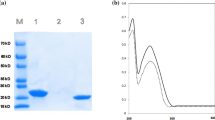Abstract
Peroxynitrite (ONOO−) is a powerful oxidant and nitrosative agent and has in vivo existence. The half life of ONOO− at physiological pH is less than 1 s. It can react with nucleic acids, proteins, lipoproteins, saccharides, cardiolipin, etc., and can modify their native structures. Action of ONOO−, synthesized in the authors’ laboratory by a rapid quenched flow process, on structural changes of commercially available RNA was studied by ultraviolet (UV), fluorescence, and agarose gel electrophoresis. Compared to native RNA, the ONOO−-modified RNA showed hyperchromicity at 260 nm. Furthermore, the ethidium bromide (EtBr) assisted emission intensities of ONOO−-modified RNA samples were found to be lower than the emission intensity of native RNA-EtBr complex. Agarose gel electrophoresis of ONOO−-modified RNA showed a gradual decrease in band intensities compared to native RNA, an observation clearly due to the poor intercalation of EtBr with ONOO−-modified RNA. Native and ONOO−-modified RNA samples were used as an antigen to detect autoantibodies in sera of patients with clinically defined breast cancer. Both direct binding and inhibition enzyme-linked immunosorbent assay (ELISA) confirmed the prevalence of native and 0.8 mmol/L ONOO−-modified RNA specific autoantibodies in breast cancer patients. Moreover, the progressive retardation in the mobility of immune complexes formed with native or 0.8 mmol/L ONOO−-modified RNA and affinity purified immunoglobulin G (IgG) from sera of breast cancer patients supports the findings of the direct binding and inhibition ELISAs. The peroxynitrite treatment to RNA at a higher concentration appears to have damaged or destroyed the typical epitopes on RNA and thus there was a sharp decrease in autoantibodies binding to 1.4 mmol/L ONOO−-modified RNA. It may be interpreted that cellular nitrosative stress can modify and confer immunogenicity on RNA molecules. Higher concentrations of nitrogen reactive species can be detrimental to RNA. However, the emergence of native as well as 0.8 mmol/L ONOO−-modified RNA as a novel antigen/substrate for autoantibodies in breast cancer patients indicates that, in future, these molecules might find a place on the panel of antigens for early diagnosis of breast cancer.
Similar content being viewed by others
References
Ali, R., Alam, K., 2002. Evaluation of Antibodies against Oxygen Free Radical-Modified DNA by ELISA. In: Armstrong, D. (Ed.), Methods in Molecular Biology: Oxidative Stress Biomarkers and Antioxidant Protocols. Humana Press, New Jersey, p.171–181. [doi:10.1385/1-59259-173-6:171]
Burney, S., Caulfield, J.L., Niles, J.S., Tannenbaum, S.R., 1999. The chemistry of DNA damage from nitric oxide and peroxynitrite. Mutat. Res., 424(1–2):37–49. [doi:10.1016/S0027-5107(99)00006-8]
Chapman, C., Murray, A., Chakrabarti, A., Thorpe, C., Woolston, U., Sahins, A., Robertson, J., 2007. Autoantibodies in breast cancer: their use as an aid to early diagnosis. Ann. Oncol., 18(5):868–873. [doi:10.1093/annoc/mdm007]
Denicola, A., Souza, J.M., Radi, R., 1998. Diffusion of peroxynitrite across erythrocyte membrane. PNAS, 95(7): 3566–3571. [doi:10.1073/pnas.95.7.3566]
Dixit, K., Khan, M.A., Sharma, Y.D., Moinuddin, Alam, K., 2011. Peroxynitrite-induced modification of H2A histone presents epitopes which are strongly bound by human ant-DNA autoantibodies: role of peroxynitrite-modified-H2A in SLE induction and progression. Hum. Immunol., 72(3):219–225. [doi:10.1016/j.humimm.2010.12.004]
Goding, J.W., 1978. Use of staphylococcal protein A as an immunological reagent. J. Immunol. Methods, 20: 241–253. [doi:10.1016/0022-1759(78)90259-4]
Goldstein, S., Lind, J., Merenyi, G., 2005. Chemistry of peroxynitrites as compared to peroxynitrates. Chem. Rev., 105(6):2457–2470. [doi:10.1021/cr0307087]
Hughes, M.N., Nicklin, H., 1968. The chemistry of pernitrites. Part I. Kinetics of decomposition of pernitrous acid. J. Chem. Soc. A, 15:450–452. [doi:10.1039/j19680000450]
Ischiropoulos, H., Zhu, L., Beckman, J.S., 1992. Peroxynitrite formation from macrophage derived nitric oxide. Arch. Biochem. Biophys., 298(2):446–451. [doi:10.1016/0003-9861(92)90433-W]
Jin, H., Zangar, R.C., 2009. Protein modifications as biomarkers in breast cancer. Biomark Insights, 4:191–200.
Khan, M.A., Dixit, K., Jabeen, S., Moinuddin, Alam, K., 2009. Impact of peroxynirite modification on structure and immunogenicity of H2A histone. Scand. J. Immunol., 69(2):99–109. [doi:10.1111/j.1365-3083.2008.02200.x]
Koppenol, W.H., Kissner, R., Beckman, J.S., 1996. Syntheses of peroxynitrite: to go with the flow or on solid grounds. Methods Enzymol., 269:296–302. [doi:10.1016/S0076-6879(96)69030-2]
Mantovani, A., Allvena, P., Sica, A., Balkwill, F., 2008. Cancer-related inflammation. Nature, 454:436–444. [doi:10.1038/nature07205]
Masuda, M., Nishono, H., Ohshima, H., 2002. Formation of 8-nitroguanosine in cellular RNA as a biomarker of exposure to reactive nitrogen species. Chem. Biol. Int., 139(2):187–197. [doi:10.1016/S0009-2797(01)00299-X]
Niles, J.C., Wishnok, J.S., Tannenbaum, S.R., 2006. Peroxynitrite-induced oxidation and nitration products of guanine and 8-oxoguanine: structures and mechanisms of product formation. Nitric. Oxide, 14(2):109–121. [doi:10.1016/j.niox.2005.11.001]
Pacher, P., Beckman, J.S., Liudet, L., 2007. Nitric oxide and peroxynitrite in health and disease. Physiol. Rev., 87(1): 315–424. [doi:10.1152/physerv.00029.2006]
Pope, S., Land, J.M., Heales, S.J.R., 2008. Oxidative stress and mitochondrial dysfunction in neurodegeneration: cardiolipin a critical target. Biochim. Biophys. Acta, 1777(7–8): 794–799. [doi:10.1016/j.bbabio.2008.03.011]
Sing, R.K., Sudhakar, A., Lokeshwar, B., 2011. From normal cell to malignancy: distinct role of proinflammatory factors and cellular redox mechanisms. J. Cancer Sci. Ther., 3(4):70–75. [doi:10.4172/1948-5956.1000061]
Tan, E.M., Zang, J., 2008. Autoantibodies in tumor-associated antigens: reporters from the immune system. Immunol. Rev., 222(1):328–340. [doi:10.1111/j.1600-065X.2008.00611.x]
Wasserman, J., Glas, U., Blomgren, H., 1975. Autoantibodies in patients with carcinoma of the breast. Correlation with prognosis. Clin. Exp. Immunol., 19(3):417–422.
Yu, H., Venkatarangan, L., Wishnok, J.S., Tannenbaaum, S., 2005. Quantitation of four guanine oxidation products from reaction of DNA with varying doses of peroxynitrite. Chem. Res. Toxicol., 18(12):1849–1857. [doi:10.1021/tx050146h]
Author information
Authors and Affiliations
Corresponding author
Rights and permissions
About this article
Cite this article
Tarannum, S., Arif, Z. & Alam, K. Binding of circulating autoantibodies in breast cancer to native and peroxynitrite-modified RNA. J. Zhejiang Univ. Sci. B 14, 40–46 (2013). https://doi.org/10.1631/jzus.B1200015
Received:
Accepted:
Published:
Issue Date:
DOI: https://doi.org/10.1631/jzus.B1200015




